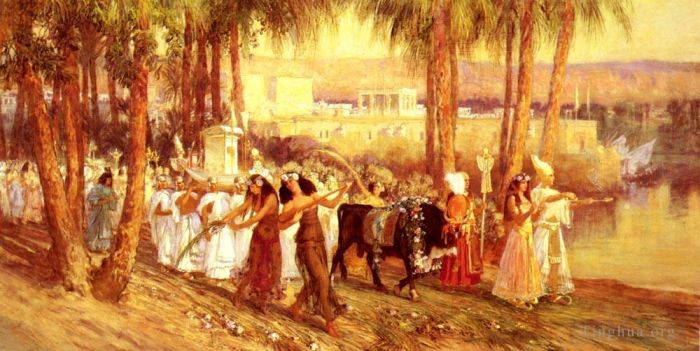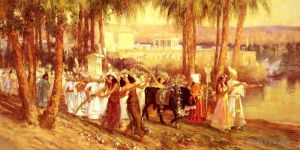An Egyptian Procession
Frederick Arthur Bridgman
- Price: Price on Request
- Art Type: Oil Painting
- Size:
- English Comments: 0
- International Comments: 0
- Creating Date:
- Introduction and Works of Frederick Arthur Bridgman >>
Keywords:
Egyptian, Procession
Work Overview
- AN EGYPTIAN PROCESSION
Frederick Arthur Bridgman
oil on canvas
33 by 63 in.
83.8 by 160 cm
Estimate 60,000 — 80,000 USD
In 1903, Frederick Arthur Bridgman exhibited an Egyptian processional scene at the Paris Salon. Called Procession en l’honneur d’Isis and featuring an elaborately detailed Egyptian interior, it was later sent to the 1904 World’s Fair in St. Louis and the National Academy of Design in New York. Though the present whereabouts of that highly acclaimed canvas are not known, the variation presented here, painted in 1902, offers a clear indication of the reason for its fame.
An Egyptian Procession was one of several historical genre scenes produced late in Bridgman’s career, and one of four major processional scenes painted between 1879 and 1919. These works were closely related — both thematically and compositionally — to the artist’s historical reconstructions of the 1870s, the most famous of which were Les funerailles d’une momie (location unknown), exhibited at the 1877 Paris Salon, and the Procession du boeuf Apis of circa 1879 (sold in these rooms, November 8, 2013, lot 66). The archaeological detail and exotic subject matter of these paintings immediately compelled comparisons to Jean-Léon Gérôme (1824-1904), Bridgman’s teacher and mentor in Paris during the 1860s. (Indeed, it was said that, “[W]hen translated into American, Gérôme means Frederic A. Bridgman,” The Perry Magazine, June 1904, 6.10, p. 421). Bridgman would later bring his own sensibility to Gérôme’s academic teachings, adopting a more naturalistic aesthetic emphasizing the opalescent colors and painterly brushwork seen here.
In the present work, the Greco-Roman temple of Philae acts as a picturesque backdrop for an ancient Egyptian religious procession in honor of the goddess Isis (Navigium Isidis), to whom it was dedicated. The pharaoh who leads the way, incense-burner in hand, wears the double crown of Upper and Lower Egypt, indicating Isis’s universal worship, while the sacred Apis bull just behind him is adorned with flowers and a solar disk. (As the cow goddess, Isis was believed to be the mother of Apis.) Bridgman made sketches at the fabled site first in 1874 and again during his numerous subsequent visits to the region; these, combined with his diligent research into the manners and customs of the ancient Egyptians, allowed him to create a remarkably vibrant — if ultimately over-embellished — scene of ritual and revel.
It is worth noting that the setting of Bridgman’s picture would have been particularly resonant in 1902 – this was the year that the Aswan Low Dam was built by the British, threatening the monuments at Philae by changing the rise and fall of the surrounding Nile River.
This catalogue note was written by Dr. Emily M. Weeks.
- Copyright Statement:
All the reproduction of any forms about this work unauthorized by Singing Palette including images, texts and so on will be deemed to be violating the Copyright Laws.
To cite this webpage, please link back here.
- >> English Comments
- >> Chinese Comments
- >> French Comments
- >> German Comments
- >>Report
- YOUNG WOMAN ON A TERRACE JEUNE FEMME SUR UNE TERRASSE
- YOUNG WOMAN FROM CONSTANTINOPLE
- YOUNG ORIENTAL WOMAN ON A TERRACE
- YOUNG NICOISE WITH A BASKET
- WOMEN WASHING CLOTHES IN A STREAM
- WOMAN ON A BALCONY ALGIERS
- WATER CARRIERS BY THE NILE
- UN CIRQUE EN PROVINCE THE AMERICAN CIRCUS IN FRANCE
- TWO HORSEMEN IN ALGIERS
- TREE TRUNK
- THE YOUNG SCRIBE
- THE WATER CARRIER
- THE STREAM AT DIVONNE
- THE SEWING LESSON
- THE PRAYER
- THE CHESS PLAYERS
- THE BARBER
- SOIR DETE
- SIROCCO OVER THE DESERT
- RETURN FROM THE HUNT
- REFLECTIONS
- PORTRAIT OF WALTER SIDNEY BAKER
- PORTRAIT OF A YOUNG WOMAN JEUNE ORIENTALE
- PORTRAIT OF A WOMAN
- PORTRAIT OF A MAN
- PENSIVE MOMENTS
- ON THE TERRACE (2)
- MARKET SCENE
- LE JOUR DU PROPHETE A BLIDAH EN ALGERIE
- LAWN TENNIS CLUB
- LA FeTE DES BOIS LES BACCHANTES
- LA CIGALE
- IN THE SOUK TUNIS
- IN THE HAREM
- IN THE COURTYARD (2)
- IDLE MOMENTS
- HORSEMEN IN ALGIERS
- HORSEMAN IN A COURTYARD
- HALT IN THE DESERT
- GARDEN IN BLOSSOM
- DANS UNE VILLE DE CAMPAGNE ALGER
- DANS LE SOUK ALGER
- CHEVAL A LA FONTAINE
- BY THE CITY GATE
- BARBARY HORSES AT CAIRO
- AT THE WATERs EDGE
- AT THE FOUNTAIN ALGIERS
- AT REST OUTSIDE THE CITY WALLS
- AT REST ALGERIA
- ARAB WOMEN ON A ROOFTOP ALGIERS BEYOND
- ARAB CHILDREN PLAYING CARDS
- APRES LA FETE PORT D ALGER
- AN EGYPTIAN PROCESSION (2)
- AN AFTERNOONS AMUSEMENT
- ALGER MAREH
- A TURKISH BEAUTY
- A MOUNTED CAVALRYMAN
- A NORTH AFRICAN COURTYARD
- A CONSTANTINOPLE BEAUTY
- A COFFEE HOUSE ALGERIA
- A STREET SCENE IN ALGERIA
- On The Coast Of Kabylie
- Aicha a Woman of Morocco
- The Orange Seller
- LIndolence
- On the Terrace
- The First Steps
- Spanish Lady
- AT THE OASIS
- Queen of the Brigands
- Cleopatras Barge
- The Reading Lesson
- ALMEH FLIRTING WITH AN ARMENIAN POLICEMAN CAIRO
- PHARAOH AND HIS ARMY ENGULFED BY THE RED SEA
- A Coastal Trail
- Pharaoh Army Engulfed By The Red Sea detail
- An Eastern Veranda
- An Arab Village
- Idle Moments An Arab Courtyard detail
- Funerailles DUne Momie
- Idle Moments An Arab Courtyard
- Procession in Honor of Isis
- Near The Kasbah
- The Return
- Scene in Morocco
- The Bathing Cove
- The Diversion of an Assyrian King
- Harem Girl
- Women Drawing Water From The Nile
- Women At The Cemetery Algiers
- River Landscape with Deer
- The Bathing Beauties
- An Egyptian Procession
- Orientalist Interior
- La Jeune mauresque Campagne DAlgiers
- The Game of Chance
- Reclining By A Stream
- The Procession of the Sacred Bull Anubis
- The Falcon Hunt
- Arab Women at the Town Wall
- Dolce Far Niente
- An Interesting Game
- Mother and Child
- The Messenger
- In the Courtyard
- Apollon Enlevant Cyrene
- Leading the Horse from Stable
- Cleopatra on the terraces of Philae 1896
- An Eastern Courtyard
- The Siesta
- In a Village El Biar Algeria
- THE MARKET SQUARE (MARKETPLACE IN NORTH AFRICA)
- The Laborer
- Design For The Decoration Of An Aeolian Harp
- The Harem Boats
- Study Of An Arab And An Arnaut Chief









 Singing Palette
Singing Palette